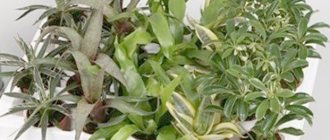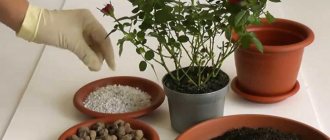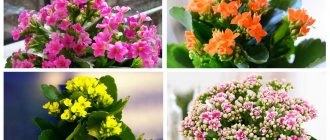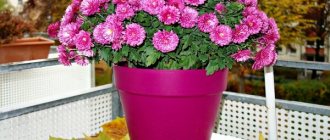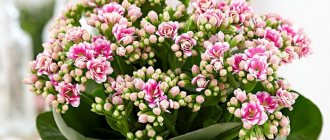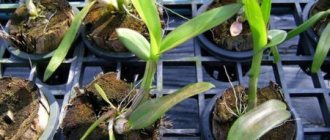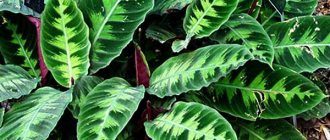Description of the plant
Along with other bromeliads, Guzmania has foliage whose bases overlap each other, creating a cup that the plant uses to store moisture. As a rule, guzmania foliage is monochromatic, but there are several varieties that have longitudinal or transverse stripes on the foliage. The length of the leaves can vary between 40-70 cm, and the average diameter of the leaf rosette is approximately 50-60 cm. Depending on the species, the length of the peduncle can also vary.
Guzmania mix begins to bloom from March to September and blooms for several months. Inconspicuous flowers, according to many gardeners, have an insufficiently decorative appearance, but are characterized by a fairly bright and glossy, red, yellow, white or orange colored bract. The height of an adult plant can reach 40-50 cm. A special feature is the death of the plant almost immediately after flowering.
Guzmania mix can be represented by a mixture of the following types of ornamental tropical crops:
- Donnell-Smith (G.donnell-smithii);
- Blood red (G.sanguinea);
- Mosaic (G.musaica);
- Lingular (G.lingulata);
- Nicaraguan (G.Nicaraguensi);
- Single-eared (G.monostachia);
- Tsana (G.azahnii).
Guzmanias, along with frisea plants, belong to the category of the most heat-loving bromeliad crops, so the ornamental plant must be cared for correctly, and care must be of high quality at all stages of growth and development.
Conditions for growing at home
Even for a novice gardener, caring for guzmania will not cause any particular difficulties if you have a greenhouse. Since the plant is of tropical origin, it needs to adapt to home conditions, so take care of the lighting, temperature and humidity in the room.
Lighting
In its natural habitat, guzmania prefers to grow in forests and on mountain slopes, and in indoor conditions it needs a well-lit place. During the period from March to September, ensure that the plant receives diffused sunlight from 10:00 to 18:00; in other times, it is recommended to place it in direct sunlight. This is also allowed between October and February. During flowering, guzmania should be protected from sunlight and artificial lighting should be provided for the plant.
Temperature
Since this plant is quite heat-loving, a comfortable temperature for the start of its flowering will be +25°C. When it has already produced flowers, this indicator should not be lower than +12°C.
Air humidity
In nature, Guzmania grows in regions with high air humidity, and at home it should be provided with similar growing conditions. So, this figure should be 65–80%.
Did you know? This flower got its name thanks to the biologist of Spanish origin Anastasio Guzman. He first described it in 1802.
However, if you live in other climates, this level of humidity can be achieved by regularly spraying the flower. You can also place the flower in a container, on the bottom of which you first lay moss, expanded clay, and bark and periodically moisten this substrate.
Photo gallery
Planting and growing
This plant is tropical and therefore requires high humidity and warmth all year round. Such conditions cannot be provided in open ground in Russia, so the plant is grown in well-heated winter gardens and on house windowsills. Flowering occurs in spring and the first half of summer; at this time it is necessary to provide the flower with moist, warm weather and no gusts of wind.
In its natural habitat - in the Amazon forests, in the southern states of the USA, Brazil and Venezuela, this species grows as an epiphyte - that is, it holds onto another plant with its roots and feeds on dead cells of its bark and other nutrients. To grow in a pot, you need to choose the right soil. It should be a mixture of coniferous bark, moss, peat, humus and compost. Store-bought substrate is good for orchids or palm trees.
Be sure to adhere to the following requirements when landing:
- After purchase, it is better not to replant or remove from the pot for the first month (exception if it is a small shipping glass);
- place a good layer of drainage in the container - expanded clay, fine gravel;
- you can mix one part of peat, bark (can be replaced with leaf humus) and half a part of sand or perlite;
- the height of the container should be no more and no less than a third of the height of the entire plant from roots to tip, the diameter is small, flowering will be problematic in containers that are too spacious;
- it is better to choose a pot that is squat and heavy so that the flower does not spill over at its height;
- place it on the west window.
It is the bracts that look exotic in Guzmania, and the flowers themselves are hidden inside the rosette and are not noticeable. The bract-spike blooms for several months, after which it dies, at which time daughter shoots are formed, which are used for seedlings. Some species, like Donatella Smith, unicolumna or mosaic, bloom with spikes of flowers that do not look like leaves.
To grow epiphyte gusmania, you need to find a picturesque piece of driftwood and attach the seedlings to it. To do this, the roots are carefully wrapped in moss and secured to the bark with wire, being careful not to damage the root system. At the same time, we should not forget about regular watering directly into the flower outlet.
Reproduction at home
Reproduction of Guzmania mix is carried out after flowering, through lateral shoots called children. The flowering process causes the gradual death of the mother rosette and the formation of children, which, as they develop, build up their own root system. After the roots reach a length of one and a half centimeters, the shoot is separated from the parent plant using a sharp, sterile garden tool. Cuts on the parent plant are processed using a garden varnish. It should be remembered that the development of the root system on children does not occur simultaneously, and shoots must be planted gradually.
Guzmania can also be propagated by seed. In this case, it is necessary to prepare planting soil based on peat chips and medium-grained sand. The seeds of the decorative crop must first be washed in a solution of potassium permanganate and dried slightly. Sowing is carried out superficially, and then the planting container is covered with a transparent film. The temperature for seed germination should be maintained at 22-24ºC.
With regular spraying, seedlings appear in about a couple of weeks. After a couple of months, the seedlings are planted in nutrient soil based on leaf and turf soil with peat in a ratio of 2:1:4. Planting at a permanent growing site takes place after about six months.
Reproduction methods
The tropical beauty has provided for its own reproduction and not only makes it possible to obtain new specimens from seeds that ripen after flowering, but also actively produces children. Therefore, to propagate Guzmania, everyone chooses the most convenient method.
Offspring
The indoor guzmania flower reproduces beautifully and readily by children. After the guzmania has flowered, its “head” gradually dies off, but nearby the mother specimen gives birth to several small offspring. They will serve as good material for propagation and at the same time retain the specific properties of the crop. The process looks like this:
- carefully remove the plant along with the earthen lump from the pot;
- separate the babies with a sharp knife;
- treat the cut areas with crushed coal;
- plant the specimens in different cups with loose soil;
- pour and cover with film or a glass jar.
If all the plants are planted in one container, then they will have to be replanted later, and guzmania does not like to be disturbed. Therefore, it is better if the children are transplanted into different containers.
Seeds
Planting a crop with seeds is more troublesome and time-consuming. Material for sowing can be bought in a store or collected independently from a flowering plant. Seeds are produced in capsules under the stipules. They are sown in containers with a mixture of peat and sand, placed in a well-lit place, covered with film. In 2-3 weeks the first shoots will appear. After 3 months, the overgrown specimens can be planted. The final transplant of guzmania is needed after six months.
How to separate Guzmania babies. Video
The best varieties for home
If a florist has a desire to decorate their home with such exotic flowers, the first thing they start doing is choosing a variety. In nature, this plant is a fairly bright mix of colors, and in culture there are even more of them!
The most popular varieties of Guzmania are the following:
| Variety name | Description |
| Rondo reed Minor | A variety with white flowers that are beautifully set off by red stipules and dark green foliage. The plant has a short stem and compact size. The root system of the variety is very weak |
| Donell Smith | The plant's bright lemon flowers blend seamlessly with pale green foliage. The peduncle is elongated, with bright red stipules, pyramidal in shape. After flowering, it forms seeds that are used by breeders to create new varieties. |
| One-Eared Minor | A variety with yellowish-green leaves and a very bright peduncle with stipules streaked with brown or pink. |
| Mosaic Minor | A variety with decorative variegated leaves and a spreading rosette shape. The variety is distinguished by bright pink stipules and small pale yellow flowers. |
| Nicaraguan Tempo | The leaf blades of the variety are green, the peduncle is small, immersed in a rosette of leaves. Flowers reddish-orange, stipules bright red |
Flower lovers often prefer to grow red guzmanias, as they are believed to bring harmony in relationships into the home. Whether this is true or not, everyone can find out from their own experience. Fortunately, this flower does not require much effort.
Landing in the ground
Before planting a plant, it is worth deciding on the capacity and composition of the soil for this.
Guzmania growing on a windowsill
The root system of the flower is very small, so there is no need to prepare a large container. It is desirable that it be a small pot, the diameter of which is within 12 cm.
In order for the container to stand confidently on the surface, you will need some weight.
Soil for guzmania can be of several types. Let's consider three options:
- Very crushed fern roots - 3 parts. And also the crushed root system of sphagnum moss - one part
- Leaf soil – 2, pine bark – 2, moss – 1, sand – 1 part
- Turf soil – 2, peat – 4, humus – 2, sand – 1 part
It is very important to maintain the ratio when adding components, since the development of the plant depends on it.
Drainage must be placed at the bottom of the pot and then the guzmania is moved.
This must be done extremely carefully, since the root system of the plant is very fragile and can be easily damaged. It is advisable to move it with an old clod of earth. It will be safer. After the plants are in the new pot, prepared soil is added. And that is all.
Planting guzmania in the ground is not at all difficult; for this you need to prepare the soil and container.
Home care rules
Growing guzmania mix is not too difficult, which makes it possible for novice gardeners to cultivate this indoor plant. Attention should be paid to temperature, humidity, watering and fertilizing.
Temperature and humidity
At the resting stage, indoor guzmania mix needs a temperature of 18-21°C. During the active growing season, including the flowering period, it is recommended to maintain the temperature within 22-24°C, which will allow the plant to bloom for three months. Tropical ornamental crops require a fairly high level of humidity, so the plant must be provided with regular moisture. In spring and summer, the aboveground part of the guzmania should be sprayed a couple of times a day with settled water at room temperature. In winter, foliar spraying is reduced to two to three times a week.
Watering and fertilizing
To irrigate the soil in a flower pot, only settled water at room temperature is used. A characteristic feature of epiphytic guzmania is the superficial location of rather tender roots, which are prone to rotting as a result of stagnation of water in the soil. In autumn and winter, watering should be very moderate, as the top layer of soil dries out. In the spring-summer period, irrigation activities are carried out once a day.
It is very important to remember that during the watering process it is necessary to fill the central funnel, which is formed by a leaf rosette, with water. It is recommended to feed exotic ornamental crops with a special mixture for bromeliad epiphytic plants. Fertilizers are applied a couple of times a month during the active growing season. The leaf rosette of an indoor ornamental plant is filled with fertilizer diluted with warm water.
How to properly care for Guzmania
Caring for a guzmania flower and replanting it at home requires certain knowledge. First of all, it is worth remembering that this is a heat-loving exotic beauty that prefers diffused light and high humidity. When the flowering period begins, the plant needs a temperature of at least 25 degrees, although 20 degrees is enough for a flowering plant, but the minimum should be 13 degrees.
It is worth spraying in winter to a lesser extent, observing an interval of a day or two; the procedure is carried out in the morning, so that the moisture has time to evaporate before evening. In this case, water should not get on the peduncle - this will significantly shorten the flowering period.
Tips and tricks
A mandatory event that must accompany the indoor cultivation of guzmania mix is the timely and competent transplantation of the exotic plant into a shallow flower pot filled with high-quality and well-drained substrate. A plant purchased at a flower shop also needs to be replanted after purchase. It is recommended to replant young ornamental crops annually, in early spring, before the indoor plant begins to flower. Adult plants can be replanted once every two or three years, in the spring and summer, with annual amendments or addition of substrate. Guzmania transplantation must be done extremely carefully and carefully, which is due to the presence of a very delicate and vulnerable root system in the plant.
Experienced amateur flower growers recommend cutting off flower stalks, since the ripening of seed material can inhibit the growth and development of new rosettes and shoots. A houseplant, due to the characteristics of its origin, can be affected by a number of pathogenic microflora.
Useful properties of guzmania
In the wild, the plant serves as a source of moisture for small creatures, which is due to the structure of the leaves - they are distinguished by their funnel-shaped shape, where drops of rain and dew accumulate. This same property allows the flower to use as much water as is necessary for normal development.
In addition, guzmania helps purify the air. It is also believed that it harmonizes the surrounding space.
How to separate Guzmania babies (video)
Guzmania mix quite often suffers from various fungal diseases , which are provoked by increased humidity and high room temperature. In addition, the ground part of Guzmania can be damaged by plant parasites common in indoor floriculture, such as scale insects, spider mites and mealybugs. When the first signs of damage are detected, treatment is carried out with modern insecto-fungicidal agents.
Ways to stimulate guzmania flowering
Some gardeners for a long time fail to achieve new flowering from the purchased guzmania after the formation of young rosettes. You should not use any hormonal stimulants. To stimulate flowering, it makes sense to do the following:
- increase additional lighting;
- feed with fertilizers containing boron and phosphorus;
- increase the temperature around the plant to +27C;
- normalize air humidity.
A little trick is also often voiced - placing pots of guzmanias in a bag of apples for 2 weeks. It is believed that this stimulates them to throw out a flower stalk. However, practice does not always confirm the effectiveness of this method.
Guzmanias do not need artificial stimulation to bloom well. It is enough to create optimal conditions for them for natural growth and the formation of young rosettes.

